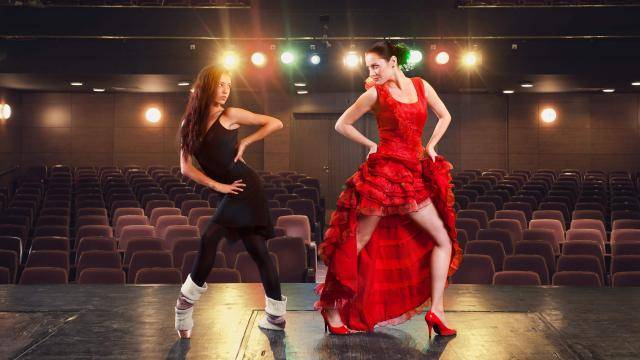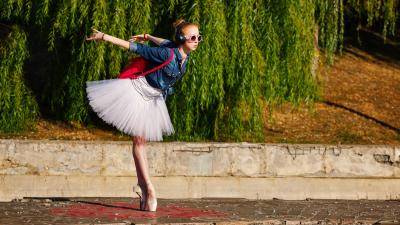Context is everything. It helps us make sense of the past and the present, offers clarity, and provides the whole picture by which arts and culture can be fully understood. The various and complicated themes of literature, schools of visual art, and political ideas can only be completely appreciated when given their historical and cultural context. The art of dance is no exception. Yet, dance education tends to focus more on instructing children on physical techniques, practices, and the shapes they must make with their bodies, while less time, if any, is spent on the contextualization of where these technical ideas and movements come from. Dance students are often not offered any kind of dance history until college, and many young dance students decide not to pursue dance in college, in favor of another field of study or do not attend college altogether. As a result, there is a lack of broad historical and cultural understanding that can be detrimental to dancers, choreographers, and audiences. Dance is so much more than shapes and movement through space. It is a collective physical manifestation of various cultures, histories, and ideas from all over the world. This is why broad statements like “Ballet is the foundation of dance” are wildly inaccurate and offer a shamefully limited understanding of the size and scope of the dance world. It is vitally important to instruct young dancers on the history and cultural origin of all the dance forms they choose to learn.
“Ballet is the foundation of dance.” This statement, and the sentiments that it embodies are incredibly detrimental to the dance world as a whole. The idea is that in order to be a successful dancer in any kind of way, one must first study and master ballet. Only then can you be treated as a “serious” dancer, worthy of notice and pay. This attitude, by its very nature, then takes the many other valid dance forms and puts them in an “other” category that is inherently viewed as “less than.” This is evident in dance educational practices across the United States, and it starts young. Most dance studios across the country put an emphasis on ballet training with their youngest students. Other dance forms are not even considered until the child is older. It is no secret that in order to get a degree in dance, one must study ballet and modern techniques at great length, while jazz, tap, or any other dance form is placed into the peripheral elective category. Additionally, “dance history” courses tend to focus mainly on the historical lineage of ballet and modern dance forms, with very little time or acknowledgement given to artists in those respective fields who were not white. Ballet and modern are seen as integral to a dancer’s training and education, while all others are typically viewed as fun extras or interesting sideshows that are not really necessary for a fruitful career in the arts. This is patently false, and ignores the necessary historical and cultural contextualization of ballet, and by extension, modern and contemporary forms. Furthermore, it unnecessarily elevates these techniques, classing them as “ideal dance forms,” while simultaneously relegating other dance techniques to mere cultural expression that ballet is somehow supreme over.
The reality is that ballet was not some perfect art form handed down. It springs out of a culture and a history with European origins, and it should be understood from that angle. Assuming that a European cultural dance technique is somehow needed to understand dance techniques that arose in Africa or Asia does not make sense. It is looking at and understanding the world from a purely Eurocentric or white view, where whiteness, white culture, and white art are seen as the default, with all other cultures and art forms seen as an aberration from the standard. This idea is evident throughout the dance world, with dancers often measured by their grasp on ballet technique before any other ability is taken into account. As J. Buoey wrote in his article entitled “Are College Dance Curriculums Too White?”, “White culture defines what is considered normal...When the word ‘technique’ is used to talk about a dancer’s grasp on ballet vernacular, we have placed it into the norm; into white dance.”
There are countless stories and examples of individuals who have been harmed by this kind of mindset. By continuing to hold a European dance form and aesthetic in higher regard than others, it has ruined dance for many, who if given the opportunity and room to grow, could have been fantastic dancers in any form chosen. It would be far better to educate children from the beginning about the origins of ballet, rather than pretending it is the ultimate form of dance expression. Alongside learning the physical practice of ballet, jazz, hip hop, or any other dance form, dancers should be educated from an early age to understand the historical context of what they have chosen to study. Contextualization helps students understand their art form beyond the walls of a studio. It gives them a window of deeper meaning into the activity they have chosen to devote their valuable time to. They are participants in a long lineage of creators, joining in with people from the past in a continuing celebration of culture and humanity. It gives movement a meaning beyond the shapes, infusing it with the histories, stories, and traditions of the past. As Crystal U. Davis notes, “Every dance form should be examined within its own historic and culture context, and not separate from that context.” This will not come without difficulty. It means confronting racism within the dance world, both past and present. It means acknowledging previous failures instead of smoothing them over. It involves stating when cultural appropriation has happened, like in aspects of Balanchine’s aesthetic and choreography or Ruth St. Denis’ entire career. Yet, this is the right and true thing to do; students deserve a full picture of dance history, not a rosy glossing-over that leaves out the injustices and negatives. We gain nothing by venerating those who came before us. Learn from what they did right and what they did wrong. They were people, nothing more.
Alongside giving a historically accurate education of ballet and western dance techniques, other dance techniques should be given equal space. Yet it is hard to find children’s dance programs that are not ballet-focused. A popular argument is that there are not enough qualified instructors in other forms and techniques. Perhaps, there is a lack of “qualified” instructors in other dance techniques because higher education in the United States consistently values ballet and modern dance over others. There are no programs where you can major in dance without being forced back into a Eurocentric dance aesthetic. Nyama McCarthy Brown argues that there should be four year programs in other dance techniques, and she offers a clear cut path for reform. If we had university programs that allowed for, say, an in-depth education in classical Indian dance forms, the dearth of “qualified instructors” in other dance forms would dissipate. In the meantime, it would be worth it for potential employers to reexamine what constitutes a qualified instructor in a dance form that is not widely accepted or taught in the United States.
Contextualization helps students understand their art form beyond the walls of a studio.
The reality is that the whole dance community loses when we look at dance with this kind of fictional hierarchical structure. It narrows the scope and forces everyone to value dance and dancing bodies along the same rubric. Ballet is not better or worse than any other dance form or technique, and if we could all be taught to understand dance forms through their proper cultural and historical lens, we would have a better appreciation for the various styles, aesthetics, abilities, and practices that come with other forms. Perhaps then, dancers and instructors who have been set aside because their speciality is in Bharatnatyam rather than ballet could flourish and receive the acclaim and monetary compensation that is their due. There is so much to be learned from other artists and cultures, and we are ignoring whole bodies of work and large amounts of knowledge that could be beneficial to us as a community.
At the end of the day, this prioritization of ballet and modern dance in the United States is another arm of systemic racism that is serving no one, and harming many, especially when it comes to arts and culture. Students are only getting half of the picture in their dance education, and this leads to a perpetuation of the status quo in our future dancers, teachers, choreographers, directors, and audiences. So no, ballet is not the foundation of dance. It is a beautiful form of dance, but does not deserve special status over other equally beautiful techniques. Dance education should extend beyond physical practices in order to provide full context, and it should cover a much wider scope than just ballet and modern. Students should be able to choose from a plethora of dance forms, and get a full, rich education, regardless of what form is chosen. Toxic power structures thrive in ignorance and darkness; education, not indoctrination is the way forward.




